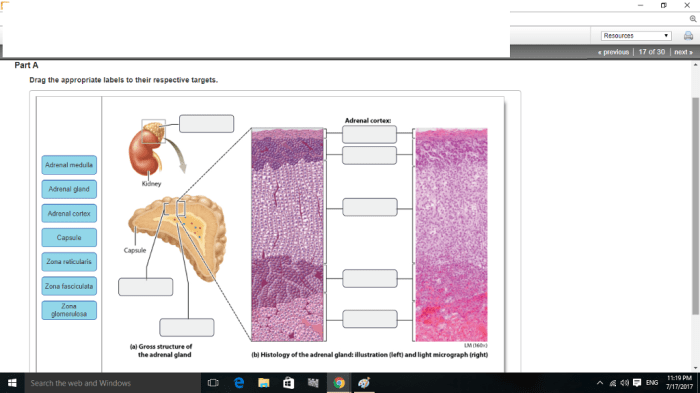Embark on an enlightening journey with the art-labeling activity: anatomy and histology of the adrenal gland. This engaging exploration unveils the intricate structures and functions of this vital organ, inviting you to discover its complexities through a unique and interactive approach.
The adrenal gland, nestled atop the kidneys, plays a pivotal role in our endocrine system. Its intricate anatomy, comprising distinct zones with specialized functions, forms the foundation of our understanding of its physiological significance.
Introduction

Accurate labeling is essential in the study of anatomy and histology of the adrenal gland. It allows researchers and students to identify and understand the various structures and components of the gland, which is crucial for understanding its function and pathology.
Labeling the adrenal gland can be challenging due to its complex anatomy and the variety of cell types present. However, art-labeling activities can be a valuable tool for enhancing the learning process and improving understanding of the gland’s structure and function.
Anatomy of the Adrenal Gland

The adrenal glands are small, triangular-shaped glands located on top of each kidney. They are composed of two distinct regions: the outer cortex and the inner medulla.
| Zone | Location | Function | Hormones Produced |
|---|---|---|---|
| Zona Glomerulosa | Outermost layer | Mineralocorticoid synthesis | Aldosterone |
| Zona Fasciculata | Middle layer | Glucocorticoid synthesis | Cortisol |
| Zona Reticularis | Innermost layer | Sex hormone synthesis | Androgens |
| Medulla | Central region | Catecholamine synthesis | Epinephrine, norepinephrine |
Histology of the Adrenal Gland
The adrenal cortex is composed of three distinct zones: the zona glomerulosa, zona fasciculata, and zona reticularis. Each zone has a unique histological appearance and function.
| Zone | Cell Type | Organization | Function |
|---|---|---|---|
| Zona Glomerulosa | Small, rounded cells | Arranged in clusters | Mineralocorticoid synthesis |
| Zona Fasciculata | Large, columnar cells | Arranged in cords | Glucocorticoid synthesis |
| Zona Reticularis | Small, polygonal cells | Arranged in a network | Sex hormone synthesis |
| Medulla | Large, polygonal cells | Arranged in clusters | Catecholamine synthesis |
Art-Labeling Activity

Art-labeling activities involve students creating labeled diagrams or illustrations of the adrenal gland. This can be done using various materials, such as paper, pencils, or digital tools.
Art-labeling activities can be used to:
- Enhance understanding of the adrenal gland’s anatomy and histology
- Improve spatial reasoning and visualization skills
- Promote collaboration and teamwork
- Make learning more engaging and enjoyable
Educational Implications: Art-labeling Activity: Anatomy And Histology Of The Adrenal Gland
Art-labeling activities can be a valuable addition to the teaching of anatomy and histology. They can help students to better understand the structure and function of the adrenal gland, and can also promote critical thinking and problem-solving skills.
Art-labeling activities can be integrated into the curriculum in a variety of ways. For example, they can be used as:
- Pre-lab exercises to introduce students to the topic
- Post-lab assignments to reinforce learning
- Assessment tools to evaluate student understanding
Q&A
What is the purpose of art-labeling activities in the study of anatomy and histology?
Art-labeling activities serve as valuable tools in the study of anatomy and histology, facilitating the visualization and memorization of complex structures. By actively labeling anatomical features, students engage with the material on a deeper level, enhancing their understanding and retention.
How can art-labeling activities be integrated into the curriculum?
Art-labeling activities can be seamlessly integrated into the curriculum through various methods. They can be incorporated as pre-lecture assignments, in-class exercises, or post-lecture assessments. Additionally, these activities can be tailored to different learning styles and skill levels, making them accessible to a wide range of students.